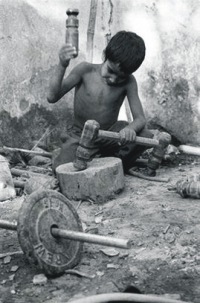International
programme on the elimination of child labour
Global
ratification campaign
 International
programme on the elimination of child labour, IPEC's aim is to work
towards the progressive elimination of child labour by strengthening
national capacities to address child labour problems, and by creating
a worldwide movement to combat it.
International
programme on the elimination of child labour, IPEC's aim is to work
towards the progressive elimination of child labour by strengthening
national capacities to address child labour problems, and by creating
a worldwide movement to combat it.
IPEC's
priority target groups are bonded child labourers, children in hazardous
working conditions and occupations and children who are particularly
vulnerable, i.e. very young working children (below 12 years of age),
and working girls.
The
political will and commitment of individual governments to address child
labour in cooperation with employers' and workers' organizations, other
NGOs and relevant parties in society such as universities and the media
is the starting point for all IPEC action. Sustainability is built in
from the start through an emphasis on in country "ownership".
Support is given to partner organizations to develop and implement measures
which aim at preventing child labour, withdrawing children from hazardous
work and providing alternatives, and improving the working conditions
as a transitional measure towards the elimination of child labour. A
phased and multi-sectoral strategy is applied consisting of the following
steps:
-
Motivating a broad alliance of partners to acknowledge and act against
child labour.
- Carrying out a situational analysis to find out about child labour
problems in a country.
- Assisting with developing and implementing national policies on child
labour problems.
- Strengthening existing organizations and setting up institutional
mechanisms.
- Creating awareness on the problem nationwide, in communities and workplaces.
- Promoting the development and application of protective legislation.
- Supporting direct action with (potential) child workers for demonstration
purposes.
- Replicating and expanding successful projects into the programmes
of partners.
- Mainstreaming child labour issues into socio-economic policies, programmes
and budgets.
By
ratifying ILO Convention No. 182, Worst Forms of Child Labour Convention,
1999, the countries commit themselves to take immediate action to prohibit
and eliminate the worst forms of child labour. This Convention is enjoying
the fastest pace of ratifications in the ILO's history since 1919. In
parallel, ILO Convention No.138, Concerning the minimum age for admission
to employment, 1973, setting forth a larger framework for the longer-term
objective of the effective abolition of child labour, has also been
receiving a surge in ratifications. The increase in ratification of
the Convention clearly demonstrates that support for the movement against
child labour is growing very rapidly throughout the world.
In
the last two years, hundreds of thousands of children throughout the
world have taken part in the global march to ban child labour. Many
reached the ILO in Geneva holding hands with adults who cared enough
to join their quest in this 'impossible dream'. These girls and boys
organized and advocated for themselves and on behalf of millions who
could not present.
The
Campaign is to bring an end to the worst forms of child labour that
are stunting the lives of millions of girls and boys. Child labour is
not jobs for kids. It is neither valuable work experience nor apprenticeship
combined with schooling that enhances a child's present and future prospects.
Child labour in its worst forms is abuse of power. It is adults exploiting
the young, naive, innocent, weak, vulnerable and insecure for personal
profit; although so many valuable efforts are going on, it is yet to
be mustered enough courage and imagination to really go beyond chipping
at the margins and actually stop it.
Intuitively,
creating and ratifying a Convention for children's benefit is the easy
part. The tougher part is finding ladders for them to climb out of the
deep pits of violence and discrimination they live in.
Source:
International Labour Organisation (ILO).